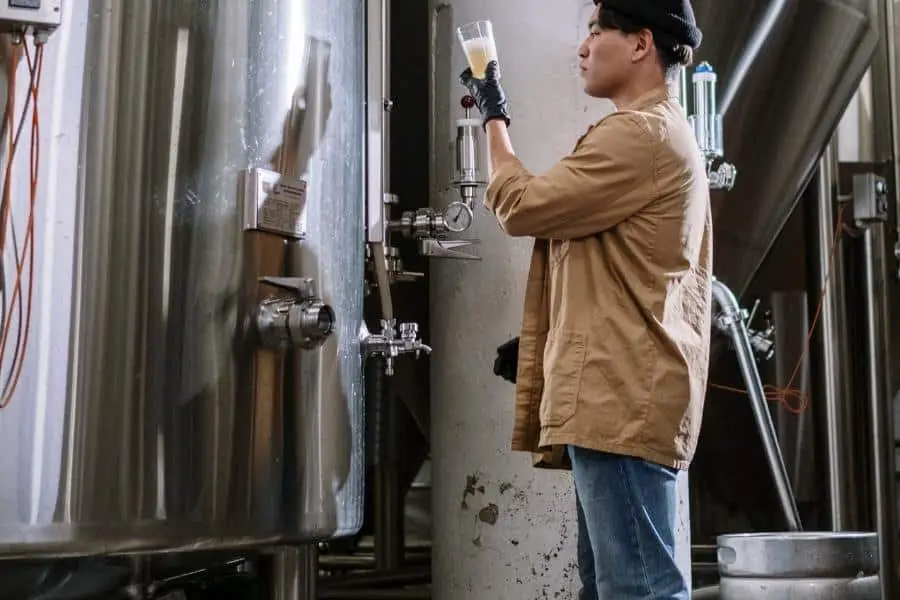If you buy something through a link in our posts, we may get a small share of the sale.
Fermentation is an essential process in making beer. It is during fermentation that the yeast transforms the sugars in the wort into alcohol and carbon dioxide gas. In primary fermentation, the yeast ferments the sugar into alcohol and CO2. So, how long can you leave beer in primary fermentation?
Contents
How Long Can You Leave Beer in Primary Fermentation?
An average primary fermentation takes about 7-10 days at 68-72 degrees Fahrenheit. This usually allows for about 75% of the sugars in the wort to be converted into alcohol. Here, the yeast is still active and will continue to ferment the beer, albeit at a slower rate. After this fermentation is complete, you can then move on to secondary fermentation.
However, there are a few things to keep in mind if you plan on leaving your beer in the first fermentation for a longer time. For instance, the beer will become sourer, and the flavor will change the longer it ferments. In addition, leaving the beer in fermentation for too long can result in the beer becoming over-carbonated.

Therefore, it is best to check on your beer every few days to ensure everything is going according to plan. Also, be sure to take gravity readings to track the progress of fermentation. Doing so will help you determine when the fermentation is complete, and it is time to move on to secondary fermentation.
Factors That Affect Fermentation Time
This type of fermentation is the first step in making beer, and it is during this stage that the yeast transforms the sugars in the wort into alcohol and carbon dioxide gas. The length of time it takes for the yeast to do this will depend on a few factors, such as:
The Type of Yeast Used
Different types of yeast will ferment at different rates. For instance, ale yeast will ferment faster than lager yeast. This is because ale yeast ferments best at warmer temperatures while lager yeast ferments best at cooler temperatures.
So, always check the instructions on the yeast packet to find out the optimum fermentation temperature for that particular strain. This will help you determine how long it will take for the yeast to complete fermentation.
The Amount of Sugar in the Wort
Another factor is the amount of sugar in the wort. The more sugar there is, the longer it will take for the yeast to ferment it all. This is because the yeast needs time to convert the sugars into alcohol.
Different sugars have different fermentation times. For instance, glucose is fermented quickly while maltose is fermented slowly. Therefore, the type of sugar present in the wort will also play a role in fermentation time.
The Temperature of the Wort
At times, the temperature fluctuates, which can also affect fermentation time. For instance, if the temperature is too cold, the yeast will go into hibernation, and fermentation will come to a standstill. On the other hand, if the temperature is too hot, the yeast will die, and fermentation will also stop.
Remember that the ideal temperature for fermentation is between 68-72 degrees Fahrenheit. Anything below or above this range will either slow down or stop fermentation.
The pH Level of the Wort
Another factor that can affect fermentation time is the pH level of the wort. The ideal pH level for fermentation is between 4.0 and 5.0. If the pH level is too high or too low, it can either slow down or stop fermentation.

Why You Shouldn’t Let Your Beer Sit For Too Long
Fermentation is good; however, letting your beer sit for too long has negative impacts that will ruin your beer. The following are some of the adverse effects:
- It leads to over-carbonation: An over-carbonated beer is very unpleasant to drink. It will be too fizzy, and the beer’s flavor will be affected.
- It can cause the beer to taste bad: If your beer sits in the fermentation for too long, it will start to develop off-flavors. The yeast will continue to consume the sugars and produce alcohol.
- The alcohol content will be too high: If you let your beer ferment for too long, the yeast will continue to produce alcohol.
Frequently Asked Questions
How Long Can I Leave Beer Before Bottling?
The ideal time to leave your beer before bottling is 2-3 weeks. This will give the yeast enough time to ferment the beer and produce carbon dioxide gas. After 2-3 weeks, the yeast will start to settle at the bottom of the fermenter.
Can I Leave Beer in Primary Fermentation for More Than 3 Weeks?
Yes, you can leave your beer here for more than 3 weeks. However, if you do so, the yeast will continue to produce alcohol, and the beer will become more and more alcoholic.
Conclusion
Monitoring your beer during fermentation is important to ensure that it doesn’t sit in primary fermentation for too long. You don’t want to bottle your beer too early or too late. Just follow the standard recipe of 2-3 weeks in the first fermentation, and you’ll be fine.

